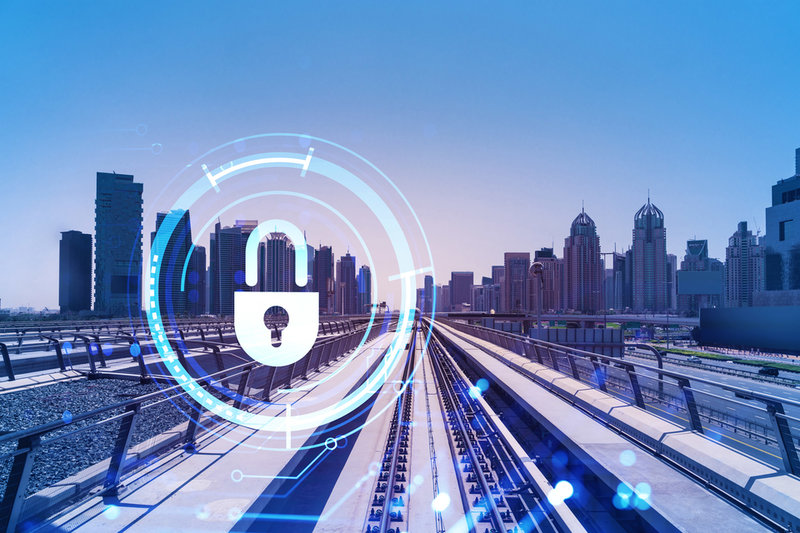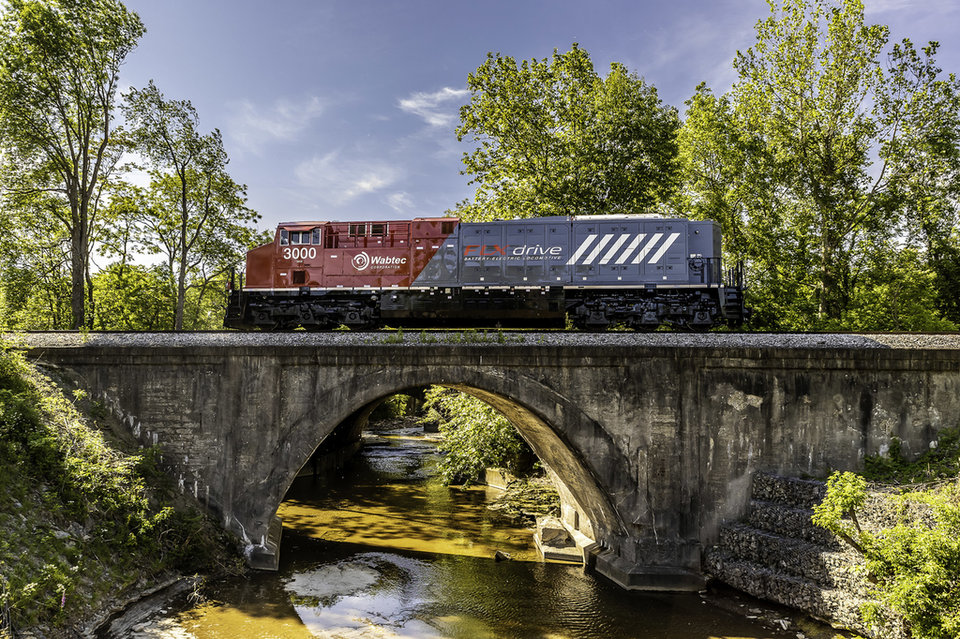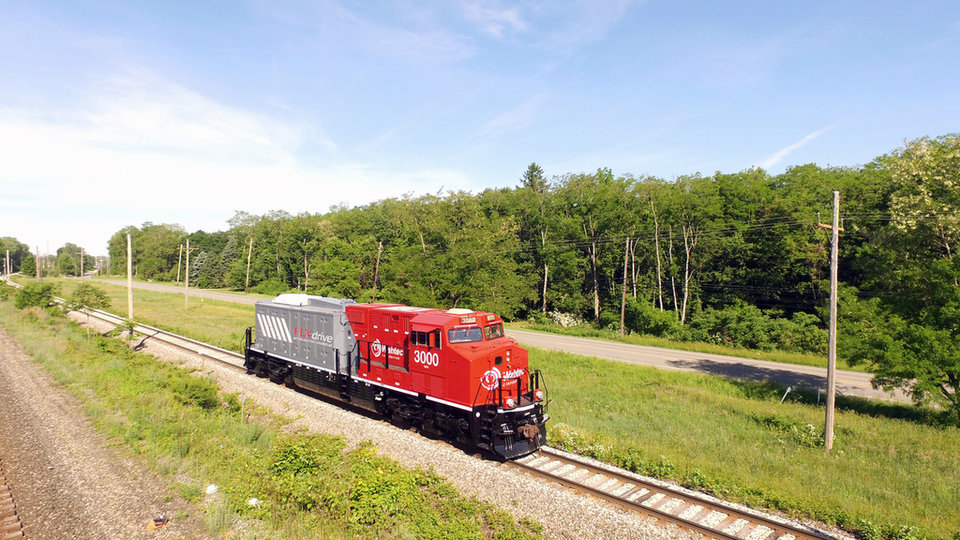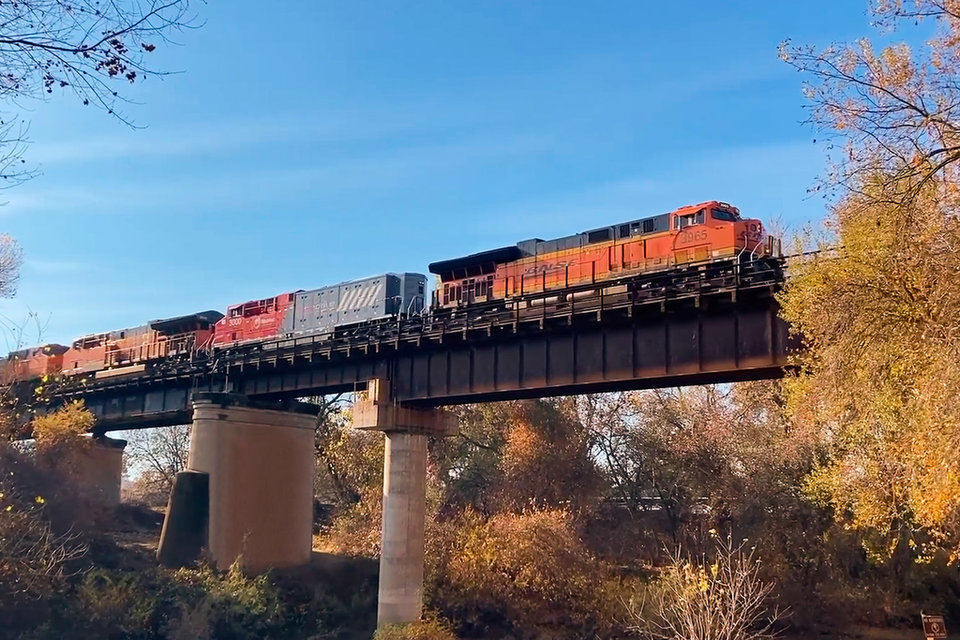Freight
The future of freight is battery and it’s painted cherry red
Train guards:
How cybersecurity is helping rail operators keep on track
Unveiled in September, the world’s first battery-electric freight train was showcased at an event held in Pittsburgh. Developed by Wabtec, a Pittsburgh-based rail freight company, the new locomotive aims to dramatically reduce carbon emissions produced by rail transport to further rail’s decarbonisation journey. Frankie Youd speaks to Wabtec to find out more.
A
lthough the rail industry is one of the leading transport sectors when it comes to minimal environmental impact, the industry is showing no signs of slowing down when it comes to decreasing its CO2 emissions.
The launch of the world’s first battery-electric freight train, named the FLXdrive, was unveiled at Carnegie Mellon University and will assist in moving over 1.7bn tons of goods that are transported across American railroads each year.
Painted cherry red, the 75ft long train has been designed with 500 lithium-ion battery modules, which have shown to cut fuel consumption by 11% when the design was trialled earlier this year.
Gina Trombley, executive vice president of sales and marketing, and chief commercial officer, Americas, explains more about the electric locomotive.

Aerial view of the derailment. Image: UK Government
Mark Thomas, rail business manager at Fugro

Mark Thomas, rail business manager at Fugro
Frankie Youd: How did the development of the train come about, when was this first discussed?
Gina Trombley: Wabtec has been exploring the application of battery technology for heavy-haul and freight rail for several years. In the past, the technology was not suitable for the type of energy needed for locomotives. Now, with advances in battery capacity, reduced costs, and improved computing capabilities, it is the right time to apply the technology to rail.
In 2018, the California Air Resource Board awarded Wabtec, BNSF Railway and San Joaquin Valley Air Pollution Control District a grant to pilot low-emissions technologies including battery-electric locomotives. It provided the opportunity to develop and demonstrate the world’s first 100% battery locomotive.
One in five candidates turn down job interviews or offers due to travel inaccessibility.

A Fuxing bullet train runs along the Lhasa-Nyingchi railway. Credit: Jiao Hongtao/VCG via Getty Images
Have there been any trials?
Yes, Wabtec demonstrated the FLXdrive battery-electric locomotive on a three-month trial during the first quarter of this year with BNSF Railway. The 2.4MWh locomotive operated as part of the railroad’s revenue service on a 350-mile route between Barstow and Stockton, California. It operated as part of a hybrid locomotive consisting of Tier 4 locomotives and proved to be a game-changer for lowering emissions.
In fact, the FLXdrive battery-electric locomotive delivered more than an 11% average reduction in fuel consumption and greenhouse gas emissions for an entire consist. It completed several trips on the route for BNSF covering more than 13,320 miles during the pilot. The locomotive saved over 6,200 gallons of fuel and reduced CO2 emissions by approximately 69 tons.
The locomotive is currently at Wabtec’s design and development centre in Pennsylvania, where it is conducting more tests on various aspects of the technology.
Has everything been developed by Wabtec or have other companies been involved?
The FLXdrive was designed and built by Wabtec and it is just the beginning. We are currently developing the next generation of this locomotive, which will operate at more than 7MWh and reduce fuel consumption and emissions by up to 30%, even while hauling several thousand tons of freight in a mile-long train.
Looking to the future, we will accelerate the shift to alternative clean energy solutions, through zero-emission hydrogen-powered locomotives. Our net-zero vision is to expand the use of freight rail, enable the elimination of over 300 million tons of CO2 annually across the global transportation network, reduce road congestion in our cities, and make transportation significantly safer for everyone.
Delivering on this vision requires partnership with key stakeholders. In 2021, Wabtec – along with Carnegie Mellon University (the nation’s leader in artificial intelligence and robotics) and Genesee and Wyoming (the largest owner of short line and regional freight railroads), proposed the creation of a Freight Rail Innovation Institute to accelerate the transition to a more widely used, efficient, and decarbonised freight rail transportation network.
Wabtec also announced a partnership with General Motors, focused on the development and commercialisation of battery technology and hydrogen fuel cell systems for Wabtec locomotives. Through this partnership and others, Wabtec is committed to pushing boundaries into alternative energy.

A Fuxing bullet train runs along the Lhasa-Nyingchi railway. Credit: Jiao Hongtao/VCG via Getty Images
Why was battery-electric chosen over other alternative power/fuel types?
Wabtec has a long history of developing alternative power and fuel types for locomotives. Batteries are just one of the many alternative solutions Wabtec is exploring.
The rail industry is on the cusp of technological advancements required to power locomotive fleets with batteries, and eventually, hydrogen fuel cells. For each diesel-powered locomotive converted to alternative energy sources up to 3,000 tons of CO2 per year can be eliminated, which will be imperative to achieving a sustainable transportation network.
How are the lithium-ion battery modules stored within the train?
The batteries are in the back of the locomotive, where the engine and radiator cabs would be on a traditional diesel locomotive. The 2.4 MWh FLXdrive locomotive that was tested in California consisted of 500 battery packs, with 36 battery cells per pack for a total of 18,000 battery cells.
During the three-month pilot, the batteries were charged at a charging station in a railyard and through regenerative braking while hauling freight throughout the trip.

A Fuxing bullet train runs along the Lhasa-Nyingchi railway. Credit: Jiao Hongtao/VCG via Getty Images
When is this hoped to be used within commercial use?
Wabtec already has several proposals out to railroads and mining companies around the world. In fact, Roy Hill – a mining operator in Australia – recently placed an order for the FLXdrive. They are the first mining company to order this technology. The locomotive will have more than 7 MWh of energy and will be delivered in 2023.
Editor's note: since we spoke to Wabtec, the Canadian National Railway has announced it will be using the FLXdrive battery-electric freight locomotive.
Do you think that battery-electric power could be the future for the freight industry?
Absolutely. Global warming is taking centre stage. Communities worldwide are focusing on how, as a global society, we impact the planet with emissions from a variety of sources – including transportation.
Even with rail’s strong environmental performance, the rail industry continues to strive to reduce its carbon footprint.
We believe accelerating a transition to a more utilised, efficient, and greenhouse gas free rail network is achievable. Battery and eventually hydrogen fuel cells will play a key role in decarbonising the rail industry.
All image credit: Wabtec